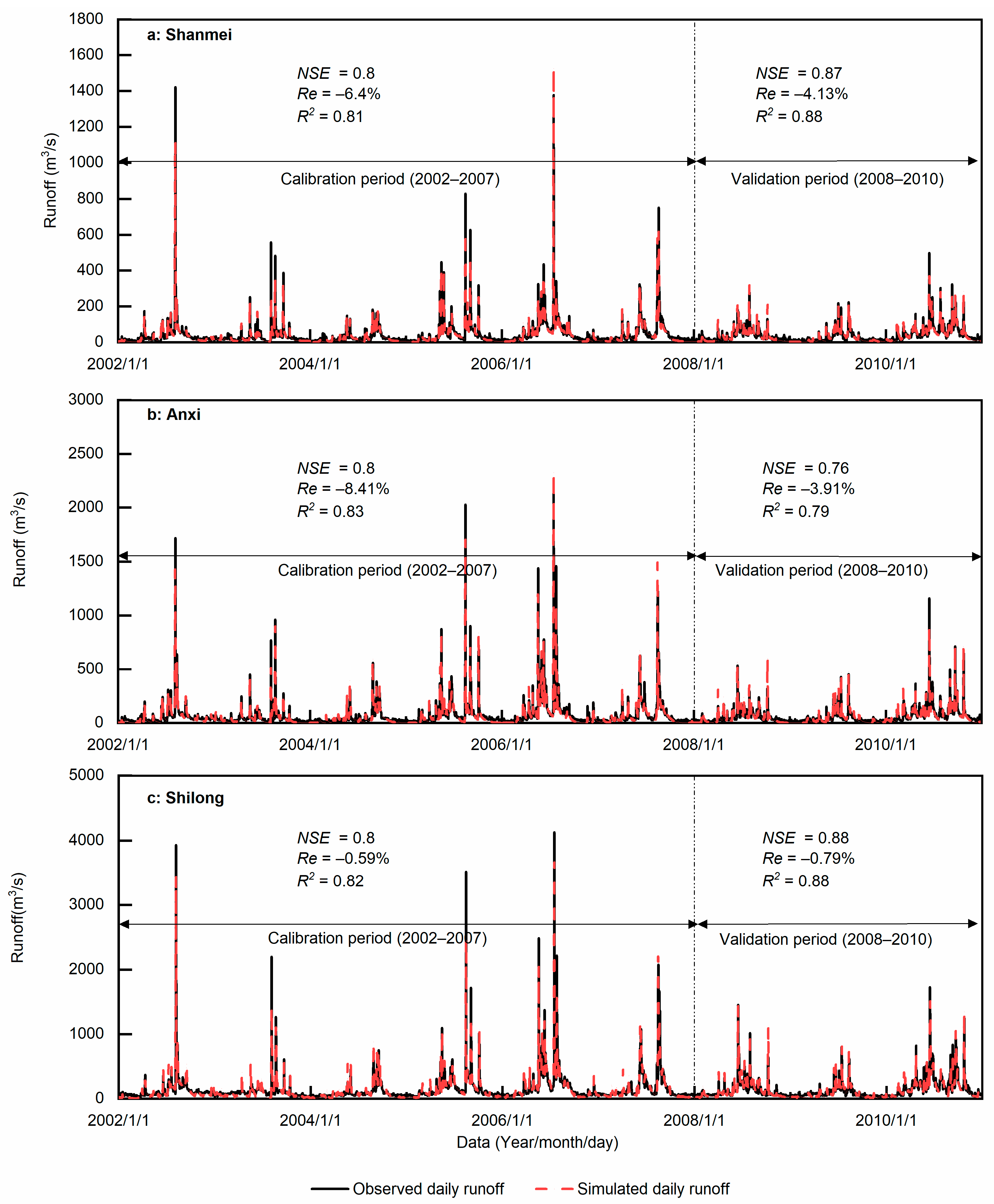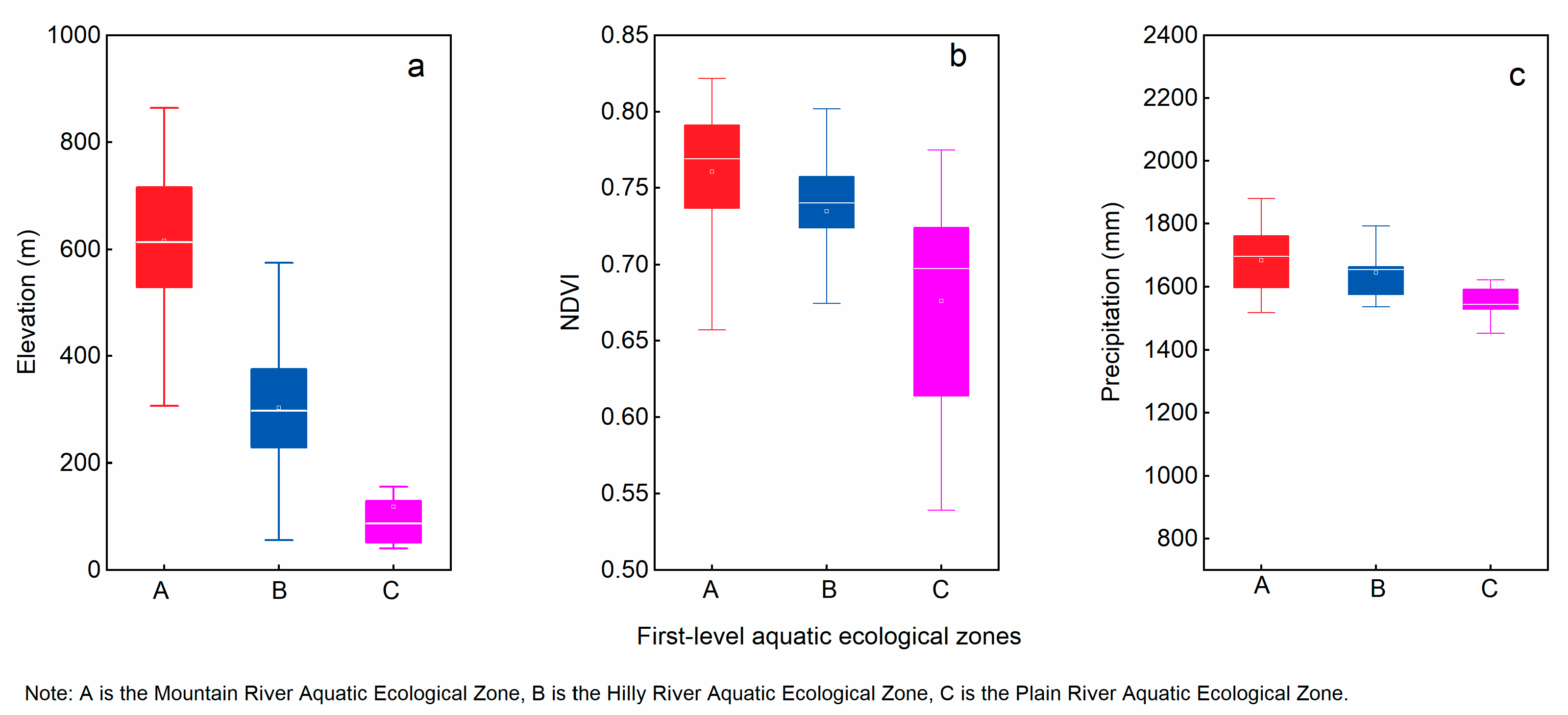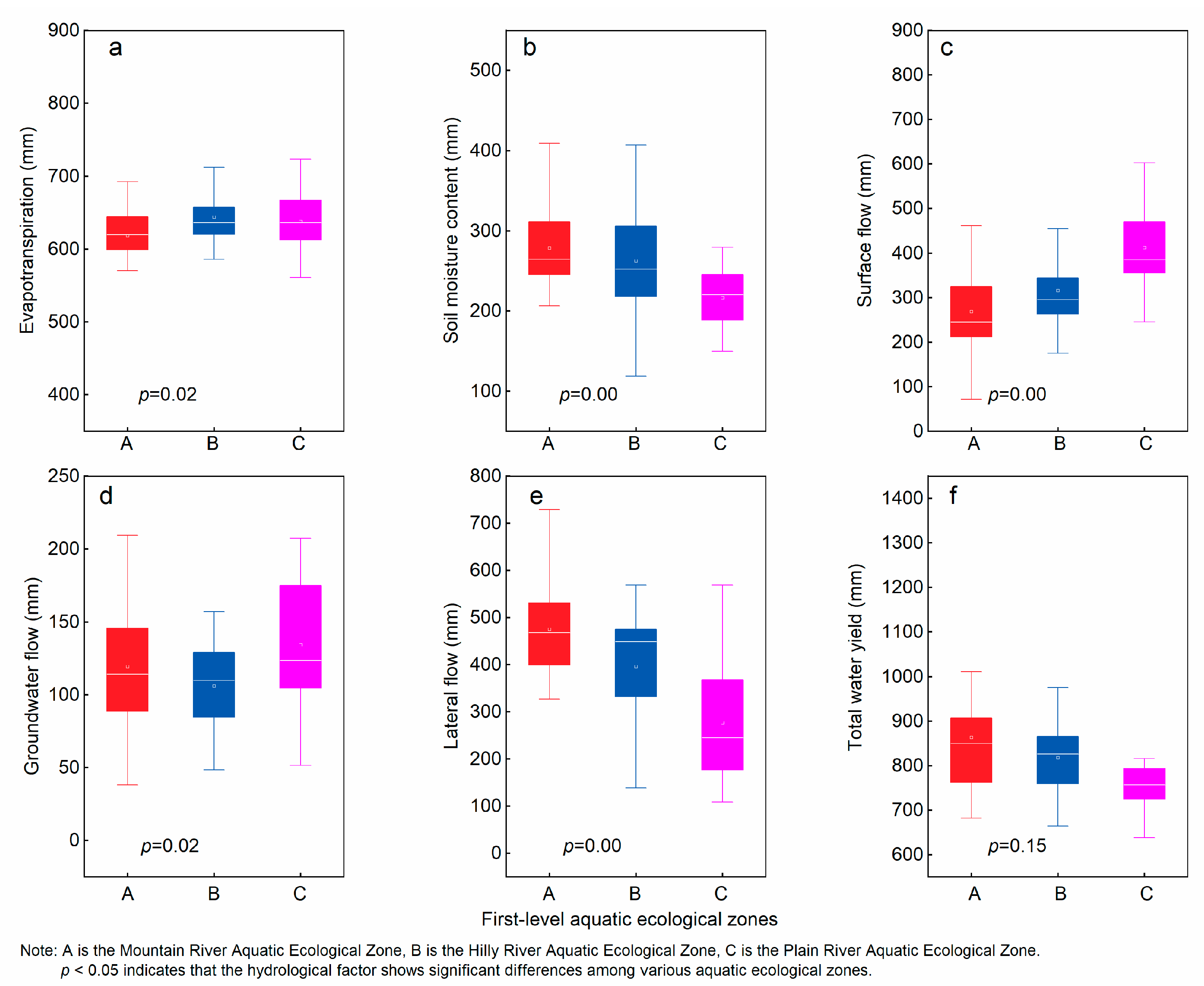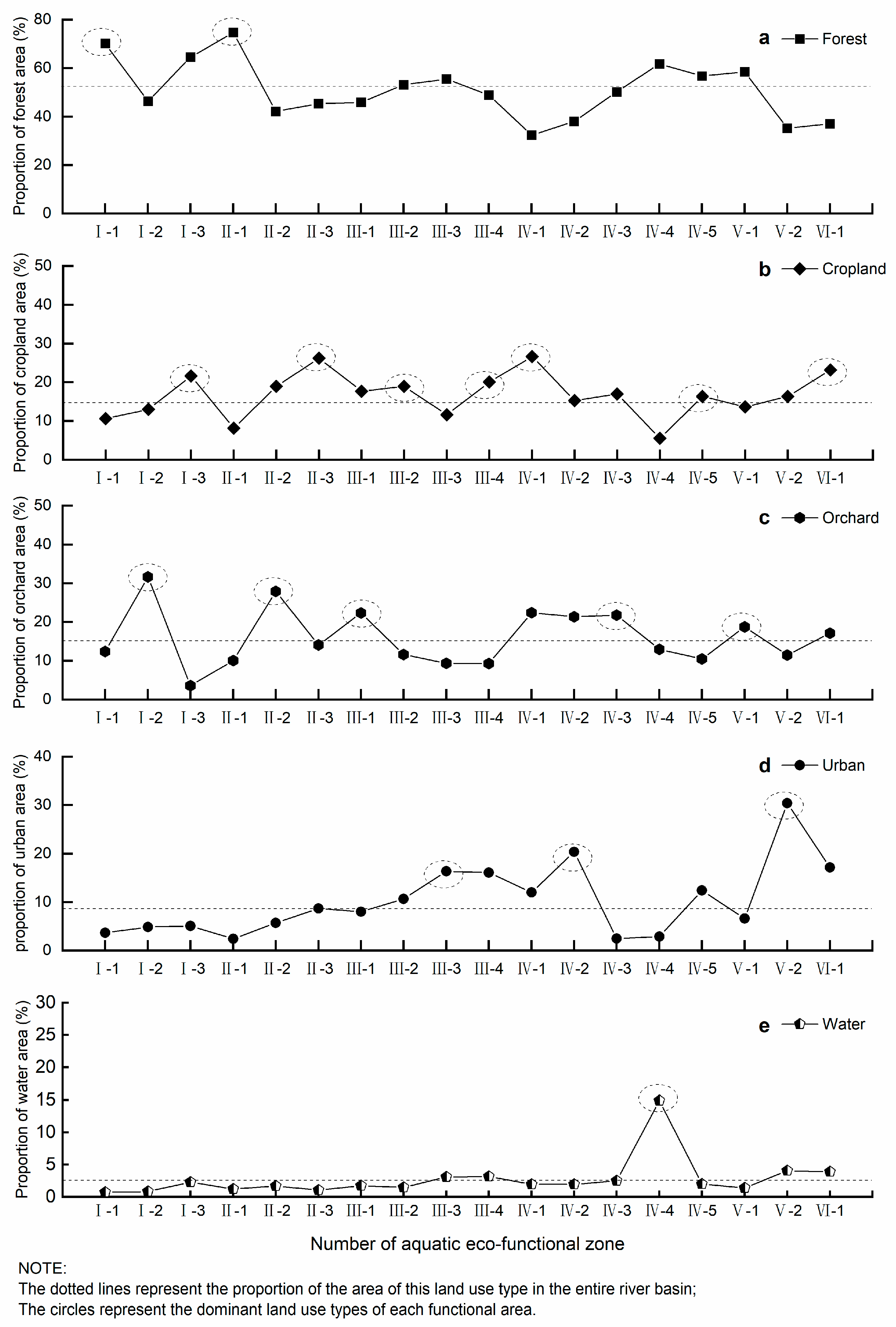Research on the Zoning of Watershed Aquatic Ecological Functions Based on a Distributed Hydrological Model
Abstract
1. Introduction
2. Study Area Overview and Data
2.1. Study Area Overview
2.2. Data Sources
3. Research Methods
3.1. Subdivision and Hydrological Simulation Based on the SWAT Model
3.2. Construction of the Regional Indicator System
3.3. Aquatic Eco-Functional Zoning
4. Results
4.1. Daily Runoff Simulation Results
4.2. First-Level Aquatic Zones and Their Characteristics
4.3. Secondary Aquatic Eco-Functional Zoning and Their Characteristics
5. Discussion
6. Conclusions
- (1)
- The Jinjiang Basin can be categorized into three categories and six first-level aquatic ecological zones based on natural environmental factors such as topography, precipitation, vegetation, and hydrology. This classification reflects the spatial variability of these factors and their effects on river ecosystems.
- (2)
- By incorporating predominant land use types, the Jinjiang Basin can be subdivided into five categories and eighteen second-level aquatic eco-functional zones, which build upon the first-level aquatic ecological zones. This subdivision highlights the extent to which human activities influence river ecosystems and the services they provide.
- (3)
- The sub-basins delineated using the SWAT model serve as critical spatial units for the eco-functional zoning of the basin, thereby preserving the integrity of river ecosystems. By integrating hydrological simulation data from each sub-basin, this methodology effectively addresses the challenges associated with obtaining hydrological zoning indicators, thereby providing reliable technical support for the ecological functional zoning of the basin.
Author Contributions
Funding
Data Availability Statement
Conflicts of Interest
References
- Omernik, J.M.; Bailey, G.B. Distinguishing between watersheds and ecoregions. J. Am. Water Resour. Assoc. 1997, 33, 935–949. [Google Scholar] [CrossRef]
- Crowly, J.M. Biogeography. Cannadian Geogr. 1967, 11, 312–326. [Google Scholar] [CrossRef]
- Omemik, J.M. Ecoregions of the conterminous United Stated. Ann. Am. Assoc. Geogr. 1987, 77, 118–125. [Google Scholar]
- Biggs, B.J.; Duncan, M.J.; Jowett, I.G.; Quinn, J.M.; Hickey, C.W.; Davies-Colley, R.J.; Close, M.E. Ecological characterisation, classification, and modelling of New Zealand rivers: An introduction and synthesis. N. Zealand J. Mar. Freshw. Res. 1990, 24, 277–304. [Google Scholar] [CrossRef]
- Harding, J.; Winterbourn, M. New Zealand Ecoregions: A Classification for Use in Stream Conservation and Management; Department of Conservation: Wellington, New Zealand, 1997; Volume 11. [Google Scholar]
- Logan, P.; Furse, M. Preparing for the European Water Framework Directive making the links between habitat and aquatic biota. Aquat. Conserv. Mar. Freshw. Ecosyst. 2002, 12, 425–437. [Google Scholar] [CrossRef]
- Moog, O.; Kloiber, A.S.; Thomas, O.; Gerritsen, J. Does the ecoregion approach support the typological demands of the EU “Water Frame Directive”. Hydrobiologia 2004, 516, 21–33. [Google Scholar] [CrossRef]
- Lorenz, A.; Feld, C.; Hering, D. Typology of streams in Germany based on benthic invertebrates: Ecoregions, zonation, geology and substrate. Limnologica 2004, 34, 379–389. [Google Scholar] [CrossRef]
- Tison, J.; Park, Y.S.; Coste, M.; Wasson, J.G.; Ector, L.; Rimet, F.; Delmas, F. Typology of diatom communities and the influence of hydro-ecoregions: A study on the French hydrosystem scale. Water Res. 2005, 39, 3177–3188. [Google Scholar] [CrossRef]
- Meyer, J.L. Stream health: Incorporating the human dimension to advance stream ecology. J. N. Am. Benthol. Soc. 1997, 16, 439–447. [Google Scholar] [CrossRef]
- Meng, W.; Zhang, N.; Zhang, Y.; Zheng, B. Integrated assessment of river health based on water quality, aquatic life and physical habitat. J. Environ. Sci. 2009, 8, 1017–1027. [Google Scholar] [CrossRef]
- Schroeder, W.; Pesch, R. Synthesizeing bioaccumulation data from the German metals in mosses surveys and relating them to ecoregions. Sci. Total Environ. 2007, 374, 311–327. [Google Scholar] [CrossRef]
- Sheng, S.; Xu, C.; Wen, T.; Wan, Y.; An, S. Division Design of Water Eco-Functioning of the River Basin. CLEAN–Soil Air Water 2015, 43, 1640–1646. [Google Scholar] [CrossRef]
- Yang, Y.; Chen, X.; Zhou, Y.; Li, W.; Chen, K. First-level and secondary aquatic ecological function division of the Yellow River Source Zone. J. Hydroecology 2023, 44, 1–9. (In Chinese) [Google Scholar]
- Frissell, C.A.; Liss, W.J.; Warren, C.E.; Hurley, M.D. A hierarchical framework for stream habitat classification: Viewing streams in a watershed context. Environ. Manag. 1986, 10, 199–214. [Google Scholar] [CrossRef]
- Liu, X.; Xu, Z.; Xu, C. A framework for aquatic ecoregion zoning. Acta. Ecologica. Sinica. 2010, 30, 4804–4814. (In Chinese) [Google Scholar]
- Baker, D.B.; Richards, R.P.; Loftus, T.T.; Kramer, J.W. A new flashiness index: Characteristics and applications to midwestern rivers and streams. J. Am. Water Resour. Assoc. 2004, 40, 503–522. [Google Scholar] [CrossRef]
- Gao, Y.; Gao, J.; Chen, J.; Xu, Y.; Zhao, J. Regionalizing aquatic ecosystems based on the river subbasin taxonomy concept and spatial clustering techniques. Int. J. Environ. Res. Public Health. 2011, 8, 4367–4385. [Google Scholar] [CrossRef] [PubMed]
- Ma, B.R.; Ma, A.Q.; Chen, S.; Li, Z.; Wang, Z.K. Function regionalization of water ecosystem for the Daliaohe Drainage Area. Period. Ocean Univ. China 2014, 44, 093–099. (In Chinese) [Google Scholar]
- Gao, Z.; Cao, X.; Huang, Y.; Li, F. Research of level I and II aquatic ecological function regionalization in Lake Dianchi basin. J. Lake Sci. 2015, 27, 175–182. (In Chinese) [Google Scholar]
- Krysanova, V.; Arnold, J.G. Advances in ecohydrological modelling with SWAT-a review. Hydrolog. Sci. J. 2008, 53, 939–947. [Google Scholar] [CrossRef]
- Zhang, D.; Chen, X.; Yao, H. Development of a prototype web-based decision support system for watershed management. Water 2015, 7, 780–793. [Google Scholar] [CrossRef]
- Ricci, G.F.; Girolamo, A.M.D.; Abdelwahab, O.M.M.; Gentile, F. Identifying sediment source areas in a mediterranean watershed using the swat model. Land Degrad. Dev. 2018, 29, 1233–1248. [Google Scholar] [CrossRef]
- Lin, F.; Chen, X.; Yao, H.; Lin, F. SWAT model-based quantification of the impact of land-use change on forest-regulated water flow. Catena 2022, 211, 105975. [Google Scholar] [CrossRef]
- Lin, B.; Chen, X.; Yao, H.; Chen, Y.; Liu, M.; Gao, L.; James, A. Analyses of landuse change impacts on catchment runoff using different time indicators based on SWAT mode. Ecol. Indic. 2015, 58, 55–63. [Google Scholar] [CrossRef]
- Wu, J.; Chen, X.; Yao, H.; Gao, L.; Chen, Y.; Liu, M. Non-linear relationship of hydrological drought responding to meteorological drought and impacts of a large reservoir. J. Hydrol. 2017, 551, 495–507. [Google Scholar] [CrossRef]
- Arnold, J.G.; Srinivasan, R.; Muttiah, R.S.; Williams, J.R. Lager area hydrologic modeling and assessment part I: Modeling development. JAWRA J. Am. Water Resour. Assoc. 1998, 34, 91–101. [Google Scholar] [CrossRef]
- Chaplot, V. Impact of spatial input data resolution on hydrological and erosion modeling: Recommendations from a global assessment. Phys. Chem. Earth. 2014, 67–69, 23–35. [Google Scholar] [CrossRef]
- Tan, M.L.; Ramli, H.P.; Tam, T.H. Effect of DEM resolution, source, resampling technique and area threshold on SWAT outputs. Water Resour. Manage. 2018, 32, 4591–4606. [Google Scholar] [CrossRef]
- Lin, B.; Chen, X.; Yao, H. Threshold of sub-watersheds for SWAT to simulate hillslope sediment generation and its spatial variations. Ecol. Indic. 2020, 111, 106040. [Google Scholar] [CrossRef]
- Zhang, D.; Chen, X.; Yao, H.; Lin, B. Improved calibration scheme of SWAT by separating wet and dry seasons. Ecol. Model. 2015, 301, 54–61. [Google Scholar] [CrossRef]
- Moriasi, D.N.; Arnold, J.G.; Van Liew, M.W.; Bingner, R.L.; Harmel, R.D.; Veith, T.L. Model evaluation guidelines for systematic quantification of accuracy in watershed simulation. Trans. ASABE 2007, 50, 885–900. [Google Scholar] [CrossRef]
- Rabbai, A.; Wendt, D.E.; Curioni, G.; Quick, S.E.; MacKenzie, A.R.; Hannah, D.M.; Kettridge, N.; Ullah, S.; Hart, K.M.; Krause, S. Soil moisture and temperature dynamics in juvenile and mature forest as a result of tree growth, hydrometeorological forcings, and drought. Hydrol. Process. 2023, 37, e14919. [Google Scholar] [CrossRef]
- Gharibreza, M.; Bahrami Samani, A.; Arabkhedri, M.; Zaman, M.; Porto, P.; Kamali, K.; Sobh-Zahedi, S. Investigation of on-site implications of tea plantations on soil erosion in Iran using 137Cs method and RUSLE. Environ. Earth Sci. 2021, 80, 34. [Google Scholar] [CrossRef]
- Chit, T.; Díaz-Pinés, E.; Butterbach-Bahl, K.; Marzaioli, F.; Valentini, F. Soil organic carbon changes following degradation and conversion to cypress and tea plantations in a tropical mountain forest in Kenya. Plant Soil. 2017, 422, 527–539. [Google Scholar] [CrossRef]
- Hamzah, Z.; Amirudin, C.Y.; Saat, A.; Wood, A.K. Quantifying soil erosion and deposition rates in tea plantation area, Cameron Highlands, Malaysia using 137Cs. Malays. J. Anal. Sci. 2014, 18, 94–106. [Google Scholar]
- Arnáez, J.; Lana-Renault, N.; Lasanta, T.; Ruiz-Flaño, P.; Castroviejo, J. Effects of farming terraces on hydrological and geomorphological processes. A review. Catena 2015, 128, 122–134. [Google Scholar] [CrossRef]
- Meng, X.; Zhu, Y.; Shi, R.; Yin, M.; Liu, D. Rainfall–runoff process and sediment yield in response to different types of terraces and their characteristics: A case study of runoff plots in Zhangjiachong watershed, China. Land Degrad. Dev. 2024, 35, 1449–1465. [Google Scholar] [CrossRef]
- Srinivas, R.; Singh, A.P.; Dhadse, K.; Garg, C. An evidence based integrated watershed modeling system to assess the impact of non-point source pollution in the riverine ecosystem. J. Clean. Prod. 2020, 246, 118963. [Google Scholar] [CrossRef]
- Chang, R.; Wang, Y.; Liu, H.; Wang, Z.; Ma, L.; Zhang, J.; Li, J.; Yan, Z.; Zhang, Y.; Li, D. Optimizing Non-Point Source Pollution Management: Evaluating Cost-Effective Strategies in a Small Watershed within the Three Gorges Reservoir Area, China. Land 2024, 13, 742. [Google Scholar] [CrossRef]
- Van Loon, A.F.V.; Gleeson, T.; Clark, J.; Van Dijk, A.I.J.M.; Stahl, K.; Hannaford, J.; Baldassarre, G.D.; Teuling, A.J.; Tallaksen, L.M.; Uijlenhoet, R.; et al. Drought in the anthropocene. Nat. Geosci. 2016, 9, 89–91. [Google Scholar] [CrossRef]
- Gudmundsson, L.; Boulange, J.; Do, H.X.; Gosling, S.N.; Grillakis, M.G.; Koutroulis, A.G.; Leonard, M.; Liu, J.; Schmied, H.M.; Papadimitriou, L.; et al. Globally observed trends in mean and extreme river flow attributed to climate change. Science 2021, 371, 1159–1162. [Google Scholar] [CrossRef] [PubMed]
- Wei, J.; Dong, N.; Fersch, B.; Arnault, J.; Wagner, S.; Laux, P.; Zhang, Z.; Yang, Q.; Yang, C.; Shang, S.; et al. Role of reservoir regulation and groundwater feedback in a simulated ground-soil-vegetation continuum: A long-term regional scale analysis. Hydrol. Process. 2021, 35, e14341. [Google Scholar] [CrossRef]
- Growns, I.; Rourke, M.; Gilligan, D. Toward river health assessment using species distributional modeling. Ecol. Indic. 2013, 29, 138–144. [Google Scholar] [CrossRef]
- Zhang, X.; Meng, Y.; Xia, J.; Wu, B.; She, D. A combined model for river health evaluation based upon the physical, chemical, and biological elements. Ecol. Indic. 2018, 84, 416–424. [Google Scholar] [CrossRef]








| Classification Level | Indicator Type | Indicator | Ecological Significance |
|---|---|---|---|
| First level | Topography | Elevation | Reflect the morphological characteristics of rivers |
| Climate | Precipitation | Reflect the status of water resources in rivers | |
| Vegetation | NDVI | Reflect the capacity for material production and water conservation | |
| Hydrology | Water yield | Reflect hydrological regulation capacity, and the ability of rivers to transport materials, energy, and sediment | |
| Secondary level | Human Activity | Land Use | Reflect the impact of human activities on river ecosystems |
| Parameters | Description | Sensitivity (t Values) | Range | Optimal Value |
|---|---|---|---|---|
| RCHRG_DP | Deep aquifer percolation fraction | −5.75 | 0–1 | 0.25 |
| SOL_AWC | Available water capacity of the soil layer | 5.46 | 0–1 | 0.11–0.34 |
| CN2 | Initial SCS curve number for moisture | 3.96 | 35–98 | 45–92 |
| GWQMIN | Threshold depth of water in the shallow aquifer acquired for return flow to occur, mm | −1.85 | 0–500 | 26 |
| SOL_K | Saturated hydraulic conductivity, mm/h | 1.66 | 0–2000 | 0.2–79.2 |
| GW_DELAY | Delay time for aquifer recharge, days | −1.58 | 0–500 | 31 |
| CH_K2 | Effective hydraulic conductivity of channel, mm/h | −1.04 | −0.01–500 | 3 |
| GW_REVAP | Revap coefficient | 0.73 | 0.02–0.2 | 0.18 |
Disclaimer/Publisher’s Note: The statements, opinions and data contained in all publications are solely those of the individual author(s) and contributor(s) and not of MDPI and/or the editor(s). MDPI and/or the editor(s) disclaim responsibility for any injury to people or property resulting from any ideas, methods, instructions or products referred to in the content. |
© 2025 by the authors. Licensee MDPI, Basel, Switzerland. This article is an open access article distributed under the terms and conditions of the Creative Commons Attribution (CC BY) license (https://creativecommons.org/licenses/by/4.0/).
Share and Cite
Lin, B.; Chen, Y.; Lin, M.; Ye, L.; Cai, M. Research on the Zoning of Watershed Aquatic Ecological Functions Based on a Distributed Hydrological Model. Water 2025, 17, 2464. https://doi.org/10.3390/w17162464
Lin B, Chen Y, Lin M, Ye L, Cai M. Research on the Zoning of Watershed Aquatic Ecological Functions Based on a Distributed Hydrological Model. Water. 2025; 17(16):2464. https://doi.org/10.3390/w17162464
Chicago/Turabian StyleLin, Bingqing, Ying Chen, Musheng Lin, Lizao Ye, and Mingjiang Cai. 2025. "Research on the Zoning of Watershed Aquatic Ecological Functions Based on a Distributed Hydrological Model" Water 17, no. 16: 2464. https://doi.org/10.3390/w17162464
APA StyleLin, B., Chen, Y., Lin, M., Ye, L., & Cai, M. (2025). Research on the Zoning of Watershed Aquatic Ecological Functions Based on a Distributed Hydrological Model. Water, 17(16), 2464. https://doi.org/10.3390/w17162464






